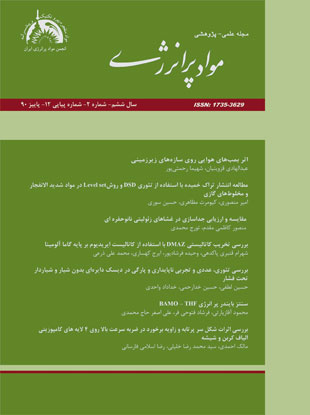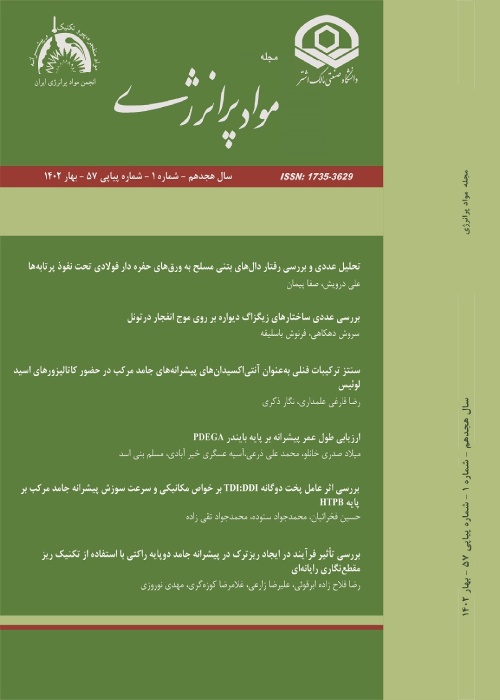فهرست مطالب

فصلنامه مواد پر انرژی
سال ششم شماره 2 (پیاپی 12، پاییز 1390)
- تاریخ انتشار: 1390/10/20
- تعداد عناوین: 7
-
-
صفحه 3ضرورت طراحی سازه های امن در مقابل انفجار بمب های هوایی در سطح زمین، بر کسی پوشیده نیست. در راستای نیل به این هدف، نحوه انفجار بمب و انتشار موج تنشی ناشی از انفجار در محیط سنگی ناپیوسته در این تحقیق مورد مطالعه و بررسی قرار گرفته و پایداری سازه های زیر زمینی در مقابل انفجار سطحی بمب ها تحلیل شده است. در این مطالعه پس از انتخاب پالس دینامیکی ناشی از انفجار یک بمب با وزن و میزان نفوذ معین در سطح زمین، و محاسبه شکل و ابعاد کراتر ایجاد شده در اثر انفجار بمب، پالس دینامیکی به صورت شعاعی به مرز کراتر اعمال شده و نحوه انتشار و میرایی موج در محیط سنگی ناپیوسته مورد مطالعه و بررسی قرار گرفته است. به منظور مدل سازی محیط ناپیوسته و انتشار موج دینامیکی در این محیط از نرم افزار المان مجزای UDEC که قابلیت تحلیل دینامیکی مدل ناپیوسته زمین را داراست، استفاده شده است. مطالعات انجام شده نشان می دهد که برای یک بمب با وزن و میزان نفوذ معین با افزایش عمق سازه، احتمال ناپایداری سازه در اثر شوک انفجار در سطح زمین کاهش می یابد. همچنین وجود ناپیوستگی های موثر (باسختی و پارامترهای مقاومتی پایین) نیز این احتمال را کاهش می دهند. تحت شرایط یکسان چنانچه زاویه شیب ناپیوستگی نسبت به خط واصل مرکز انفجار و محل سازه حدود 60 درجه باشد احتمال پایداری سازه نسبت به سایر زاویه ها افزایش می یابد.
کلیدواژگان: سازه های زیرزمینی، کراتر، پالس دینامیکی، انتشار موج، میرایی موج، روش المان مجزا، تحلیل دینامیکی -
صفحه 17در این مقاله با استفاده از ترکیب تئوری DSD و روش Level set جبهه تراک تعقیب شده است. نخست، با استفاده از یک کد DSD و نیز از طریق مراجع، روابط D-κ و برای مواد شدیدالانفجار و مخلوط های گازی به دست آمده است و سپس با استفاده از روش Level set، جبهه تراک در هندسه های مختلف تعقیب شده است. برای مواد شدیدالانفجار که در آن ها انحنا نقش مهمی را در دینامیک جبهه تراک دارد، همخوانی خوبی بین نتایج تئوری DSD و حل کامل عددی وجود داشت، در حالی که این مطلب برای مخلوط های گازی صادق نبود. به منظور مطالعه قطر بحرانی و با کمک تئوری DSD و روش Level set، مسئله عبور ناگهانی جبهه تراک از یک کانال به یک فضای نامحدود مورد بررسی قرار گرفت. بدین منظور یک معیار خاموشی تراک بر مبنای انحنای بحرانی مورد استفاده قرار گرفت. اختلاف قابل توجهی بین قطر بحرانی مخلوط های گازی که با تئوری DSD پیش بینی شده بود و نتایج تجربی به دست امده وجود داشت. نتایج نشان داد که قطر بحرانی مخلوط های گازی که در دینامیک جبهه تراک آن ها ناپایایی و سینتیک شیمیایی مهمتر از انحنا هستند، اغلب اوقات کمتر از مقدار واقعی پیش بینی می شود.
کلیدواژگان: تعقیب جبهه تراک، روش Level set، تئوری DSD، قطر بحرانی -
صفحه 51
دیافراگم های پاره شونده به عنوان شیر سریع العمل، در پرتابگرهای گازی برای مطالعه مسائل برخورد و نفوذ و در تونل شوک برای مطالعه اثرات موج انفجار و شوک بطور گسترده ای استفاده می شود. در این مقاله به منظور طراحی دیافراگم آلومینیومی در پرتابگر گازی موجود، ابتدا تئوری حاکم بر ناپایداری در دیافراگم های بدون شیار و شیاردار بررسی شده و فرآیند تغییر فرم و پارگی دیافراگم به کمک نرم افزار LS-DYNA شبیه سازی شده است. همچنین با ساخت دیافراگم های بدون شیار و شیاردار با عمق 0/1 میلی متر و سامانه ای برای آزمایش و انجام تست های تجربی، فشار پارگی برای دیافراگم ها اندازه گیری شده است. نتایج بدست آمده نشان می دهد، روابط تئوری ناپایداری برای دیافراگم بدون شیار، فشار پارگی کمتری را در مقایسه با مقادیر تجربی و عددی ارائه می دهد. همچنین در این مقاله به کمک نتایج تجربی بدست آمده، روابطی تحلیلی- تجربی برای تخمین فشار پارگی دیافراگم های بدون شیار و شیاردار ارائه شده است. مقایسه نتایج عددی بدست آمده از شبیه سازی و نتایج تجربی تطابق خیلی خوبی را نشان می دهد.
کلیدواژگان: پرتابگر گازی، تونل شوک، دیافراگم شیاردار، دیسک پاره شونده، فشار پارگی، ناپایداری -
صفحه 63
-
Page 3The necessity of designing safe structures to withstand an air strike on a ground surface is obvious. In order to meet this goal, the blast characteristics and propagation of intense wave caused by it in discontinues rock media is considered. After selecting a dynamic pulse caused by an airborne bomb, with a specific weight and penetration on the ground surface and calculation of the resulted crater, it is applied, in a radial shape, on the crater surface. Thereby the wave propagation and its damping in a discontinum media is investigated. The rock mass and propagation of dynamic wave in it is modeled using UDEC software. The results show that with increase in the depth of structure, its instability decreases against the blast caused by a bomb with specific weight and penetration. The existence of effective discontinuity also decreases this possibility. Under the same conditions the possibility of the structure stability increases if the slope angle against the line drawn to the center of the blast is about 60 degrees.Keywords: Underground Structures, Wave Propagation, Wave Damping, Discontinues Media, Distinct Element Method, Dynamic Analysis, Crater
-
Page 17In this paper the propagation of detonation waves in high explosives as well as gaseous mixtures are studied by combining the DSD theory and the level set method. In first step, the D-κ and relations for high explosive materials and gaseous mixtures are obtained. Then, using level set method, the detonation front is tracked in different geometries. A good agreement between DSD results and direct numerical simulations is observed for high explosive materials, where the curvature has an important role in detonation dynamic. Nevertheless, for gaseous mixtures the agreement is not as good as high explosives. In order to study the critical diameter problem in gaseous mixtures, the problem of detonation wave diffracting from a channel into an unconfined space is investigated. In this problem, the detonation failure criterion, based on the critical curvature concept, is utilized. A considerable difference between critical diameters which had been predicted by DSD theory and the experimental results is observed. The results indicate that the critical diameter in gaseous compositions (where the unsteadiness and chemical kinetic are more crucial than the curvature) is often underestimated by the DSD theory.Keywords: Tracking, Detonation Front, Level Set Method, DSD Theory, Critical Diameter
-
Page 29Zeolites are microporous crystalline materials with a uniform pore size distribution on a molecular scale and with high thermal and chemical stability. Zeolite membranes NaA, ZSM-5, Mordenite< NaX and NaY grown onto seeded mullite supports. Separation performance of zeolite membranes were studied for water-dimethylhydrazine mixtures using pervaporation (PV) method. The best flux and separation factor of the membranes were 0.62 kg/m2.h and 52000, respectively, for NaA zeolite membrane. Strong electrostatic interaction between ionic sites and water molecules (due to its polar nature) makes the zeolite NaA membrane very hydrophilic. Zeolite NaA membranes are thus well suited for separating liquid-phase mixtures by pervaporation method. In this study, experiments were conducted with various UDMH–water mixtures (1–20 wt. %) at 25. Total flux for UDMH–water mixtures was found to vary from 0.331 to 0.241 kg/m2.h with increasing UDMH concentration from 1 to 20 wt.%. Ionic sites of the NaA zeolite matrix play a very important role in water transport through the membrane. These sites act both as water sorption and transport sites. Surface diffusion of water occurs in an activated fashion through these sites. The precise nanoporous structure of the zeolite cage helps in a partial molecular sieving of the large solvent molecules leading to high separation factors. A comparison between experimental flux and calculated flux using Stephan Maxwell (S.M.) correlation was made and a linear trend was found to exist for water flux through the membrane with UDMH concentration.Keywords: Nanopore, Pervaporation, Zeolite Membranes, Stephan Maxwell Model
-
Page 39Hydrazine catalytic propulsion system is the most conventional system in satellite orbit control. Dimethyl amino ethyl azide (DMAZ) is a replacement candidate monopropellant for hydrazine in such systems. Catalyst IR/γ-Al2O3 has been reported for decomposition of DMAZ. However, there is no information about performance conditions of the catalyst. For prediction of decomposition ability of DMAZ by the catalyst, several catalysts with various amounts of IR were prepared and characterized. Then, a micro-reactor was designed to evaluate the catalytic activity. The prepared catalysts were tested and examined at various conditions. The results showed that the increase in temperature of catalytic bed and decrease in space velocity led to an increase in catalytic activity. Also, an optimum amount of 42% in IR showed maximum activity at 205 °C of catalytic bed and 2.82 hr-1 of space velocity.Keywords: DMAZ, Catalytic Decomposition, Ir, γ AL2O3, Catalytic Activity, Space Velocity, Bed Temperature
-
Page 51
Rupture discs are used as high speed valves in gas guns to study impact and penetration phenomena. These devices are also used extensively in shock tunnels for the study of explosion and shock waves. In the article grooved and ungrooved rupture discs are studied numerically as well as experimentally in order to design an Aluminum diaphragm to be used in a gas gun. Instability and rupture analysis of discs is the main concern in this paper. LS-DYNA software has been used in order to simulate deformation and rupture phenomena. A tester and several diaphragms were constructed and tested in order to empirically determine rupture pressure. Rupture pressure were measured experimentally for ungrooved and grooved diaphragm with 1mm depth. Using experimental data, a semi-empirical relation is developed which delivered approximate rupture pressure for grooved and ungrooved diaphragm. The results of the numerical and experimental investigations were compared and good agreements were obtained.
Keywords: Gas Gun, Shock Tunnel, Grooved Diaphragm, Rupture Disc, Burst Pressure, Instability -
Page 63In this study, BAMO-THF as an appropriate energetic binder was produced. Initially, BAMO as energetic monomer was obtained from Pentaerythritol after three steps reactions. Then, BAMO-THF copolymer was produced via cationic polymerization method using BAMO and THF as monomers, 1,4-butanediol as initiator and Boron triflouride as catalyst. Products obtained from each step were analyzed by FT-IR, 1H NMR, 13C NMR, GPC and CHN analyses. Results indicated that all products (intermediates and BAMO-THF copolymer) are successfully produced with high purity.Keywords: BAMO, THF Copolymer, Energetic Binder, Cationic Polymerization
-
Page 69In this study, 4 composite layers of plain carbon fiber fabric, plain glass fiber fabric and carbon-glass [carbon-glass-carbon-glass] fiber fabrics, are tested under high speed impact (118 m/s) with flat or half-spherical projectile in impact angles of 0, 30 and 45 degrees compared to the normal impact, and the amount of damage as well as their ballistic limit was studied. Results showed that with increase in the impact angle striked with the flat projectile, the ballistic limit decreased by 30% and the damage area decreased by 36%. Also, with the increase in the impact angle striked with the half-spherical projectile in speed of 118 m/s on 4 layers of carbon fiber fabric and glass fiber fabric, the ballistic limit increased by 25% and the damage area decreased by 40%. The maximum damage area and ballistic limit was in 4 layers of glass fiber fabric and the minimum damage area and the ballistic limit was observed in 4 layers of carbon fiber fabric, that with integration of these 2 fabrics and generating 4 layer fabric of carbon-glass, the high ballistic limit of glass fiber fabric and low damage area of 4-layer carbon fabric is achieved in 4 layer carbon-glass laminate.Keywords: Impact Angle, High Velocity Impact, Projectile Nose, Glass Fiber, Carbon Fiber


